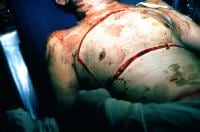Two studies comparing compression-only CPR with conventional CPR:
BACKGROUND: The role of rescue breathing in cardiopulmonary resuscitation (CPR) performed by a layperson is uncertain. We hypothesized that the dispatcher instructions to bystanders to provide chest compression alone would result in improved survival as compared with instructions to provide chest compression plus rescue breathing.
METHODS: We conducted a multicenter, randomized trial of dispatcher instructions to bystanders for performing CPR. The patients were persons 18 years of age or older with out-of-hospital cardiac arrest for whom dispatchers initiated CPR instruction to bystanders. Patients were randomly assigned to receive chest compression alone or chest compression plus rescue breathing. The primary outcome was survival to hospital discharge. Secondary outcomes included a favorable neurologic outcome at discharge.
RESULTS: Of the 1941 patients who met the inclusion criteria, 981 were randomly assigned to receive chest compression alone and 960 to receive chest compression plus rescue breathing. We observed no significant difference between the two groups in the proportion of patients who survived to hospital discharge (12.5% with chest compression alone and 11.0% with chest compression plus rescue breathing, P=0.31) or in the proportion who survived with a favorable neurologic outcome in the two sites that assessed this secondary outcome (14.4% and 11.5%, respectively; P=0.13). Prespecified subgroup analyses showed a trend toward a higher proportion of patients surviving to hospital discharge with chest compression alone as compared with chest compression plus rescue breathing for patients with a cardiac cause of arrest (15.5% vs. 12.3%, P=0.09) and for those with shockable rhythms (31.9% vs. 25.7%, P=0.09).
CONCLUSIONS: Dispatcher instruction consisting of chest compression alone did not increase the survival rate overall, although there was a trend toward better outcomes in key clinical subgroups. The results support a strategy for CPR performed by laypersons that emphasizes chest compression and minimizes the role of rescue breathing. (Funded in part by the Laerdal Foundation for Acute Medicine and the Medic One Foundation; ClinicalTrials.gov number, NCT00219687.)
CPR with chest compression alone or with rescue breathing
N Engl J Med. 2010 Jul 29;363(5):423-3
BACKGROUND: Emergency medical dispatchers give instructions on how to perform cardiopulmonary resuscitation (CPR) over the telephone to callers requesting help for a patient with suspected cardiac arrest, before the arrival of emergency medical services (EMS) personnel. A previous study indicated that instructions to perform CPR consisting of only chest compression result in a treatment efficacy that is similar or even superior to that associated with instructions given to perform standard CPR, which consists of both compression and ventilation. That study, however, was not powered to assess a possible difference in survival. The aim of this prospective, randomized study was to evaluate the possible superiority of compression-only CPR over standard CPR with respect to survival.
METHODS: Patients with suspected, witnessed, out-of-hospital cardiac arrest were randomly assigned to undergo either compression-only CPR or standard CPR. The primary end point was 30-day survival.
RESULTS: Data for the primary analysis were collected from February 2005 through January 2009 for a total of 1276 patients. Of these, 620 patients had been assigned to receive compression-only CPR and 656 patients had been assigned to receive standard CPR. The rate of 30-day survival was similar in the two groups: 8.7% (54 of 620 patients) in the group receiving compression-only CPR and 7.0% (46 of 656 patients) in the group receiving standard CPR (absolute difference for compression-only vs. standard CPR, 1.7 percentage points; 95% confidence interval, -1.2 to 4.6; P=0.29).
CONCLUSIONS: This prospective, randomized study showed no significant difference with respect to survival at 30 days between instructions given by an emergency medical dispatcher, before the arrival of EMS personnel, for compression-only CPR and instructions for standard CPR in patients with suspected, witnessed, out-of-hospital cardiac arrest. (Funded by the Swedish Heart–Lung Foundation and others; Karolinska Clinical Trial Registration number, CT20080012.)
Compression-Only CPR or Standard CPR in Out-of-Hospital Cardiac Arrest
N Engl J Med. 2010 Jul 29;363(5):434-42


_7093.jpg)

